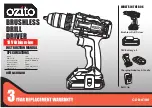
3. Avoid accidental starting. Be sure the trigger is off before connecting to the air
supply. Carrying pneumatic tools with your finger on the trigger, or connecting
pneumatic tools to the air supply with the Trigger on, invites accidents.
4. Remove adjusting keys or wrenches before turning on the tool. A wrench or a key
that is left attached to a rotating part of the tool may result in personal injury.
5. Do not overreach. Keep proper footing and balance at all times. Proper footing
and balance enables better control of the tool in unexpected situations.
6. Use safety equipment. Always wear ANSI-approved safety glasses underneath a
full face shield, and hearing protection.
Use and Care
1. Use clamps or other practical ways to secure and support the work piece to a stable
platform. Holding the work by hand is unstable and may lead to loss of control. Only
work on a workpiece that is properly secured.
2. Do not force the tool. Use the correct tool for your application. The correct tool will
do the job better and safer at the rate for which it is designed.
3. Do not use the power tool if the trigger does not turn it on or off. Any tool that cannot
be controlled with the Trigger is dangerous and must be replaced.
4. Disconnect the air hose from the tool before making any adjustments, changing
accessories, or storing the tool. Such preventive safety measures reduce the risk
of starting the tool accidentally.
5. Store idle tools out of reach of children and other untrained persons. Tools are
dangerous in the hands of untrained users.
6. Maintain tools with care. Do not use a damaged tool. Tag damaged tools Do not use
until repaired.
7. Check for misalignment or binding of moving parts, breakages of parts, damaged air
hose (not included), and any other condition that may affect the tool's operation. If
damaged, have the tool serviced before using. Many accidents are caused by poorly
maintained tools.
8. Use only accessories that are recommended by the manufacturer for your model.
Accessories that may be suitable for one tool may become hazardous when used on
another tool.
Service
1. Tool service must be performed only by qualified repair personnel. Service or
maintenance performed by unqualified personnel could result in a risk of injury.
2. When servicing a tool, use only identical replacement parts. Follow instructions in
the Inspection, Maintenance and Cleaning section of this manual. Use of
unauthorized parts or failure to follow maintenance instructions may create a risk
of injury.
SPECIFIC SAFETY RULES
1. To avoid accidental injury, always wear ANSI-approved safety glasses, a full face
shield, and hearing protection when operating the tool.
2. Use clean, dry, regulated, compressed air at 90 PSI. Do not exceed the
recommended 90 PSI. Never use oxygen, carbon dioxide, combustible gases, or
any other bottled gas as a power source for this tool.
3. When connecting to the air supply: Prior to each use, if an automatic oiler is not
used, add two drops of air tool oil (not included) into the air inlet fitting of the tool.
4. Always disconnect the tool from its compressed air supply source, and squeeze the
Trigger to release all compressed air in the tool before performing any maintenance
or service.
"
"
2 of 5






















